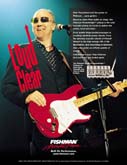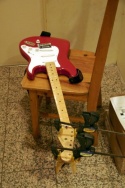Pete’s Gear: Fender Eric Clapton model Stratocasters
Introduction: Pete Townshend and the Fender Eric Clapton model Stratocaster
July 2016: Fender announces Limited Edition Pete Townshend Custom Shop Stratocaster
See Pete’s signature page or fendercustomshop.com for more info.
Beginning with the first Who reunion tour in 1989, to the present, Pete Townshend has used the Fender Eric Clapton Stratocaster model on stage, with the Who exclusively, and for solo shows, primarily. Each tour presents different customizations to the guitar’s features, though all are stock models.
General model specifications:
- Contoured alder Stratocaster body.
- Special ‘V’-shape maple neck (9.5″ radius); 25½″ scale; Bi-Flex truss rod; Micro-Tilt neck adjustment.
- Three Gold Fender-Lace Sensors, with five-position switch.
- TBX (master) circuit (in place of second control); 25db active mid-boost circuit (in place of third control).
- Eric Clapton signature decal on headstock.
- Fender vintage machine heads.
- Single-ply white pickguard, with vintage-style screw holes (on some models).
The guitars are strung with light-gauge nickel strings (either Ernie Ball or D’Addario), .011–.052 (.011, .015, .018p, .032, .042, .052); the neck is set straight with medium action. The guitars are numbered (a la the ’76-’79-era Les Paul Deluxes) with small black-on-white stickers at the heel of the guitar.
Signature models
In July 2016, Fender announced a Custom Shop Limited Edition Pete Townshend Stratocaster®, based on Pete’s use of the Eric Clapton Signature model dating back to 1989.
Alan Rogan discusses Pete’s Stratocasters and Vibro-Kings, in 2007.
Variations: 1989–2002
1989
- Some with Kahler 2710 locking tremolo system with locking nut; some with Fender vibrato.
- Ernie Ball Light Gauge Nickel-Wound strings, .011–.052 with .018p substituted for the G string (.011, .015, .018p, .030, .042, .052).
- Torino Red models
1996–1998
- Some with Floyd Rose Pro locking vibrato, some with locking nut. Some with Floyd Rose Deluxe locking tremolo.
- Olympic White, Torino Red (1996/97 only) and Shoreline Gold models.
- Most with Fishman piezo transducer saddle-pickup system for mock-acoustic sound. Extra knob installed just above cord jack behind bridge to control piezo output.
- Piezo models have stereo output: stereo signal sent to splitter box, with magnetic pickup signal to amp; piezo output to direct box, to board.
- Ernie Ball or D’Addario .011–.052 nickel strings (.011, .015, .018, .032, .042, .052).
1999–2000
- Fishman Powerbridge piezo transducer saddle-pickup system for mock-acoustic sound. Extra knob installed just above cord jack behind bridge to control piezo output.
- Fender tremolo systems on some, Fishman VMV (vintage-mount vibrato) Powerbridge Tremolo on some.
- One Olympic White, four to six Torino Red models.
- For the first few 2000 shows, a Shoreline Gold Fender Stratocaster with a white pickguard (not a Clapton Signature model, but had the same Gold Lace Sensor pickups).
- Stereo output: stereo signal sent to splitter box, with magnetic pickup signal to amp; piezo output to direct box, to board.
- Ernie Ball .011–.052 nickel strings (.011, .015, .018, .032, .042, .052).
- Sperzel locking tuners.
2001–2013
- Fishman Powerbridge piezo transducer saddle-pickup system for mock-acoustic sound. Extra knob installed just above cord jack behind bridge to control piezo output.
- Fishman VMV (vintage-mount vibrato) Powerbridge Tremolo set for floating vibrato.
- Onboard EMG buffer preamp (adjustable using four trim pots — a 3-band EQ and volume — through a hole at the rear of the guitar), for acoustic signal.
- Customisations by Gordon Wells of Knight Guitars, Surrey.
- One Olympic White, four to six Torino Red and one Shoreline Gold models.
- Ernie Ball .011–.052 nickel strings (.011, .015, .018, .032, .042, .052).
- Sperzel locking tuners.
- Stereo output: stereo signal sent to Pete Cornish splitter box, with magnetic pickup signal to amp; piezo output to Demeter or Fishman direct box, to board.
2014–present
- Details as above, but no Eric Clapton signature decal on headstock.
- Ernie Ball .010–.048 nickel strings (.010, .013, .017, .026, .036, .048).
2016
- In addition to above, Pete began using two Fender Custom Shop Limited Edition Pete Townshend Stratocasters (one red, one gold) modified with two Gibson mini-humbucker pickups instead of the standard three Lace Sensor pickups. These debuted 10 Sept. 2016, Oberhausen, Germany.
2017
- The guitars are fitted with emery boards behind the bridge, for Pete to “rough up” the edges of guitar picks as needed.
Amplification:
-
1989, 1996–1997:
- Two to four rack-mounted Mesa/BOOGIE Studio Preamps, no pedal effects.
-
1999:
- One or two Hiwatt DR103W amplifier heads into Hiwatt SE4123 4×12 extension cabs; effects are MXR Dyna-Comp into Boss OD-1 Overdrive.
-
1998, 2000–2005:
- One or two Fender Vibro-King 3×10 combos and 2×12 extension cabs; effects are MXR Dyna-Comp into Boss OD-1 Overdrive.
-
2006–present:
- Two Fender Vibro-King 3×10 combos and 2×12 extension cabs (plus two more as spare); effects in Pete Cornish pedalboard are T-Rex Replica Echo, Boss OD-1 Overdrive and Demeter COMP-1 Opto-Compulator compressor.
-
2010–2012:
In addition to the two Fender Vibro-King combos and extension cabs, one Lazy J 20 1×12 amplifier stacked on Lazy J (2×12?) speaker enclosure.
-
2016:
In addition to the two Fender Vibro-King combos and extension cabs, one Lazy J Model J 40 3×10 combo amplifier.
-
- Two Fender Vibro-King 3×10 combos and 2×12 extension cabs (plus two more as spare); effects in Pete Cornish pedalboard are T-Rex Replica Echo, Boss OD-1 Overdrive and Demeter COMP-1 Opto-Compulator compressor.
2000–2002 basic signal path:
Guitar (magnetic) pickups —> MXR Dyna-Comp —> Boss OD-1 —> [splitter box] —> Vibro-King/cab —> SM-57 (or Shure KSM44) —> PA
Fishman (piezo) pickup —> EMG preamp —> [splitter box] —> Demeter VTDB-2B Tube Direct Box DI —> PA
2004–2006 basic signal path:
Guitar (magnetic) pickups —> MXR Super Comp —> Boss OD-1 —> [splitter box] —> Vibro-King/cabs (and Hiwatt) —> mic —> PA
Fishman (piezo) pickup —> EMG preamp —> [splitter box] —> Demeter VTDB-2B Tube Direct Box DI —> PA
2006–present basic signal path:
Guitar (magnetic) pickups —> [splitter box] —> Cornish custom effects pedal board —> [splitter box] —> Vibro-King/cabs (three sets) —> mic —> PA
Fishman (piezo) pickup —> EMG preamp —> [splitter box] —> Demeter VTDB-2B Tube Direct Box or Fishman DI —> PA
See the main equipment index for full rig details.
Note: In 2010, a KSM313 ribbon mic was used to mic the Vibro-Kings. See microphones for more detail.
Selected quotes from Pete Townshend
All quotes and references are copyright their original owners and are included for reference only.
Pete, on his guitar sound in 1996:
“I hope that prior to the tour I didn’t raise fan’s hopes that I was going to play electric all the way through the show. In fact at the first dates, and even later in the electric Love Reign O’er Me, there was a bit of an illusion going on. Although I was holding a Stratocaster all the way through the first two dates in the USA it was heavily modified. I was actually playing via an acoustic transducer fitted into the guitar which produced a rhythm sound very close to my white Gibson J200. I only used the electric channel a few times in the set.”
“The lead v. acoustic thing is not just about my hearing, my intransigence, my fear of spearing myself or my musical preferences, it is not just about ‘Pete.’ It is about musical and presentational dynamics as well. Remember that I write mainly on acoustic guitar. A lot of the songs from Quadrophenia, like a lot of Who songs, sound best when I play acoustic. Ideally I’d like to play acoustic and electric at the same time on stage. Simon did a fantastic job on electric and covered me very well. I settled for what I think all Who fans would have wished — the best mix.”
Guitar World, November 1989
Pete’s main solidbody electric is an Eric Clapton Signature Strat made by Fender. The Guitars are custom fitted with Kahler 2710 locking twang bars. The electronics (all stock) include three Fender Gold Lace sensor pickups, a five-position switch, master volume and a patented TBX master tone control (the TBX acts like a normal tone pot; however, clicking it past 10 produces a slight boost which creates a super-bright vintage sound). Exclusive to the E.C. model is Fender’s active mid-range boost, located where the second tone control is normally found. By gradually rotating the pot, the mid-range is boosted and the output of the guitar is somewhat increased. The Fender sports .011–.052 Ernie Ball nickel strings, a gauge or two lighter than Townshend has used in the past.
Guitar Player, September 2000
- How is the action set on your guitars?
I like an absolutely dead-flat neck with medium action — not too low. I know some players like to let a little curve in the middle of the neck so they can keep the action lower, but I think guitars are meant to have a dead-flat neck. My tech tends to reset guitars every night because when they travel, they bend a little bit.
Guitar Player, September 1989
You know, the acoustic guitar is very much a symbol. And I don’t play acoustic on everything now. I’ve found that i can get away with playing what I’ve found to be a very good guitar which Eric championed for Fender, the Eric Clapton Model, which is a wonderful all-around guitar for me. It’s one of those guitars where the actual rhythm sound on it, the undistorted sound, the pickup, and the string balance are very good. I don’t know how they’ve achieved it, but it’s very, very good — it’s almost as good as an acoustic. Also, if you wind it back, it’s got an active distortion pad in it, where it gets distorted without the volume increase, and that enables me to get just the right amount of dirt, but keep the level low.
Alan Rogan:
“Pete’s using an old Clapton Strat, meaning it has the Lace Sensors rather than the Noiseless pickups. It does have a Fishman on board with the extra knob, but otherwise it’s stock, and he goes through the one or two Vibro-Kings. All my buddies come to the show, including John Porter, the producer and a great guitar player himself. They all say they never heard a live sound — anywhere, ever — as good as Pete’s.”
Fender Europe note on Pete’s customised Stratocasters:
That Strat® has a Fishman/EMG acoustic pickup in the body. The extra knob is used to blend in the pickup, creating a range of sounds from 100% acoustic to electric. This was fitted by a chap called Gordon Wells, who lives and works in Surrey.
Gordon is the son-in-law of the late luthier-to-the-stars, Dick Knight (1907–1996) who was a well respected British guitar maker to clients such as Dave Gilmour, Paul McCartney, Pete Townshend, and Mike Rutherford (among others).
Alan Rogan, in “The Stratocaster chronicles. Fender: Celebrating 50 years of the Fender Strat,” by Tom Wheeler, 2004
Townshend’s more recent Eric Clapton Strats have an onboard Fishman Power Bridge transducer for acoustic tones, an EMG buffer preamp, stereo output, and an extra volume knob mounted on the body. Alan Rogan had a hand in the guitar’s components and layout. He explained: “The EMG preamp is a huge part of the sound. It makes the acoustic side sound far better than a proper acoustic guitar with a pickup on it. The electric and acoustic sides can be used separately, but Pete likes to blend them, which is why I placed the extra volume knob where it is, for easy accessibility and to also leave room for bridge adjustments. Pete loves these guitars, along with his amp of choice, a Fender Vibro-King with a 2×12 extension cabinet. Gordon Wells at Knight Guitars (Weybridge, Surrey) reshapes the necks to the same dimensions of the earlier Clapton Strats, which Pete much prefers.”
Photo Gallery
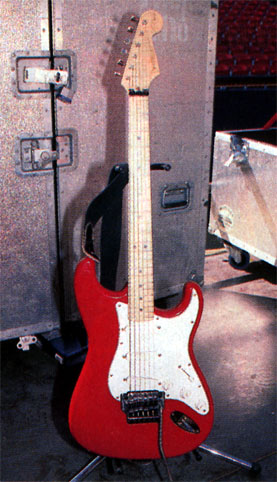
Ca. 1989, showing Kahler 2710 locking tremolo system with locking nut.
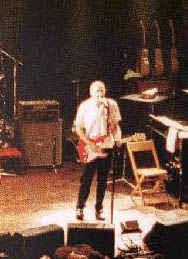
Ca. 1999, playing through Hiwatt DR103W half-stack. Note three Gibson J-200 acoustics backstage.
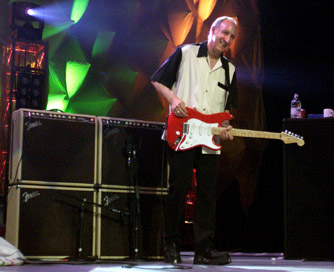
Ca. 2000, in front of dual Fender Vibro-King combos and extension cabs. Note Fishman Powerbridge tremolo and control for Fishman piezo transducer saddle-pickup system.
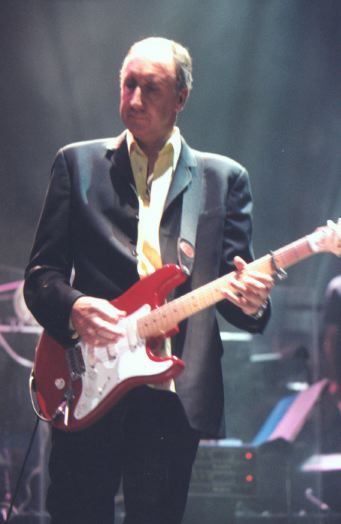
Ca. 1997, showing control knob for Fishman piezo transducer saddle-pickup system; Floyd Rose Deluxe locking tremolo. Note the two Mesa-Boogie studio preamps in background.
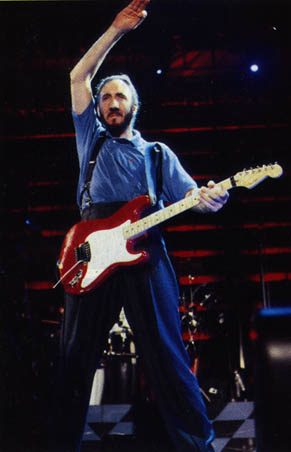
Ca. 1989, with Kahler 2710 tremolo and locking nut.
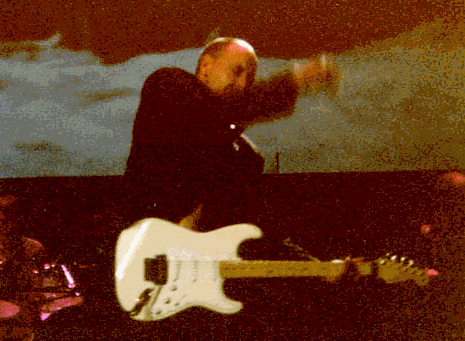
Ca. 1997, with Floyd Rose Pro locking tremolo with no piezo transducer.
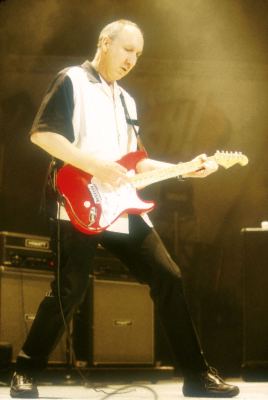
Ca. 1999, Las Vegas, showing control knob for Fishman piezo transducer saddle-pickup system, with two Hiwatt DR103W half stacks in background.
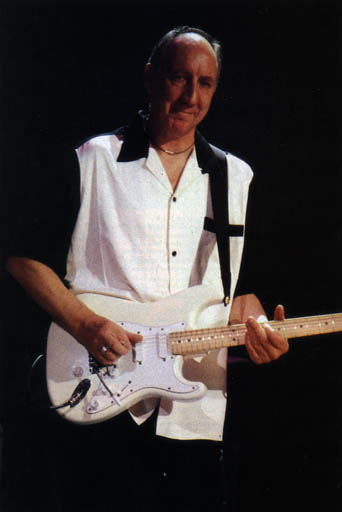
Ca. 1999, with Olympic White model fitted with Fishman VMV Powerbridge tremolo and extra control knob.
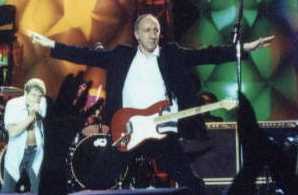
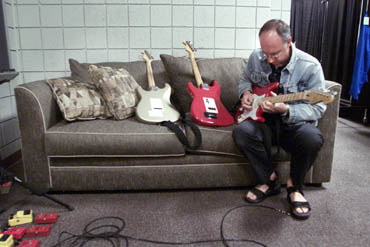
Ca. 2000, Pete in the dressing room with two Torino Red Fender Eric Clapton model Stratocasters, showing customised cover plate on the back over the Fishman control, and one Shoreline Gold non-Clapton model. Effects are LED and non-LED MXR Dyna-Comp pedals and Boss OD-1 overdrive pedals.
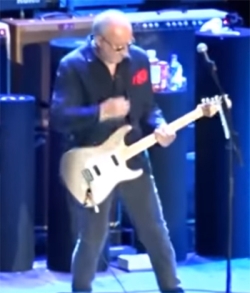
Click to view larger version. September 2016, Limited Edition Pete Townshend Stratocaster in gold, modified with two mini-humbucker pickups.
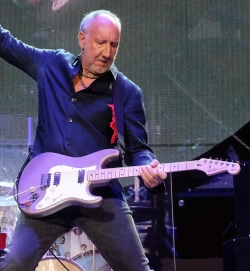
Click to view larger version. October 2016, Limited Edition Pete Townshend Stratocaster in gold, modified with two mini-humbucker pickups.
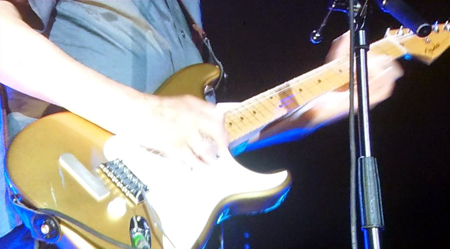
May 2019, detail of Stratocaster with emery board affixed to body.
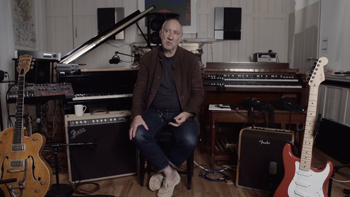
Click to view larger version. Ca. 2016, Pete at his studio promoting the Fender Custom Shop Limited Edition Pete Townshend Stratocaster®, with, from left, Gretch Chet Atkins, Fender Vibro-King, Fender Acoustic SFX and Fender Eric Clapton Stratocaster.
Resources and Information
Acknowledgements
Thanks to the following for assistance with this page:
- Ron Kiska
- TommyGuitars
Manufacturer’s links:
- Fender: fender.com
- EMG: emgpickups.com
- Fishman: fishman.com (offline)
- Fishman VMV Powerbridge Tremolo: fishman.com/products/details.asp?id=63
- Floyd Rose: floydrose.com
